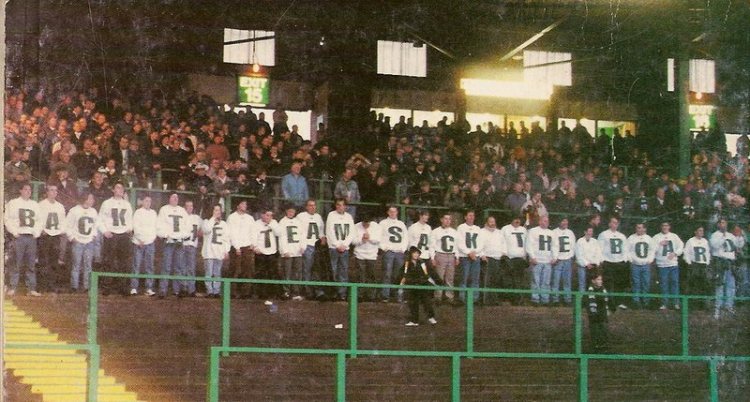The Celtic PLC AGM is now set for Friday 21st November 2014 to decide, among other issues, a motion from the Celtic Trust that the club should pay all its employees the Living Wage of £7.85 an hour. It had been revealed at last year’s AGM by club Chairman Ian Bankier that 178 of the club’s employees were paid only the minimum wage of £6.50 per hour. Since our first article on the issue (read it here: https://theshamrockglasgow.wordpress.com/2014/10/12/celtic-and-the-living-wage-what-the-hell-do-we-care/) there have been a number of major developments.
The Celtic Board have confirmed that they will again be recommending to shareholders that the motion to pay all employees £7.85 per hour be voted down – see the AGM Notice here: http://cdn.celticfc.net/assets/downloads/Celtic_plc_AGM_Notice_2014.pdf. The fact that thousands of Celtic supporters have signed a petition urging the Board to reconsider this issue appears to have been ignored. This documents sets out the rationale for the Directors’ position. It starts off by pointing out that the club have retained ‘Investors in People’ status and that “the club engages with staff on a regular basis” – although it is not prepared to invest an extra £1.35 per hour into their employees’ well-being or recognise trade unions who could effectively represent the club’s workers.
They just can’t get enough . . . of our club’s money
For any worker whose company has been through the ‘Investors in People’ programme they know this is a meaningless exercise which delivers no practical benefits to a workforce yet senior managers like to get excited about “IiP status” the way that Scottish football journalists arouse themselves into a thrashing frenzy over the prospect of Celtic playing against a lower league team from Govan.
The Board’s statement finally gets to the heart of the matter: “the Board does not believe that it is appropriate to commit to any non-statutory initiative in terms of remuneration policy, however well-intentioned.” It would appear the club’s “well-intentioned” Social Charter conveniently wasn’t in their minds in drafting that statement. Interestingly the statement does not repeat Ian Bankier’s claim from last year’s AGM that the cost of introducing the Living Wage would be around £500,000 – presumably because such a claim is absolute nonsense and does not stand up to scrutiny. The Board had the opportunity here to give a detailed business case explaining why the Living Wage would be unaffordable – by explaining the jobs, salaries and hours involved of those currently on the minimum wage and why increasing these would be too great a cost. Instead they gave no details at all. Their silence speaks volumes.
 PLC Bonus – No, Living Wage – Yes
PLC Bonus – No, Living Wage – Yes
And the actual reason why Celtic’s Board won’t pay 178 employees an extra £1.35 an hour to give them a Living Wage? The Board believes that “in order to act in the best interests of the company at this time, particularly given the economic uncertainty of Scottish football, it must retain control of its remuneration policy.” Economic uncertainty? The club’s profits last year increased to £11.17 million from £9.74 million in 2013. These profits are unlikely to suffer any kind of noticeable dent from introducing a Living Wage. But of course, Scottish football is in difficult and unusual times, we keep being told. Quite simply, if the biggest and most profitable club in Scottish football can’t pay all its employees the Living Wage then surely no club can. And certainly not a First Division club like Hearts, fresh out of administration . . .
How uncomfortable must the Celtic Directors have felt then when Hearts FC announced on 28th October that they had in fact signed up to pay all their employees the Living Wage? Their owner Ann Budge announced: “Having reviewed the salary structure across all areas of the club, we propose to implement the nationally-approved Living Wage across all staff, including part-time and contract workers. We believe it is entirely in keeping with the values we hold dear as a club.” While they have an owner called Budge, we have a Board who won’t budge.
Ronald McDonald and Peter Lawwell celebrate their minimum wage workforces
The single reason relied upon by the Celtic Board for resisting the Living Wage was blown out of the water by that Hearts decision. They are a club significantly poorer than Celtic who can only dream of turning over a profit in excess of £10 million. Yet it is they who (rightfully) earned the plaudits for being the first Scottish football club to commit to paying all their staff the £1.35 an hour that independent experts say is vital to give working people a decent opportunity to provide for themselves and their families in modern Scotland.
The Board’s actions on the Living Wage issue have brought shame on them and again soiled the club’s reputation. At a time when Celtic Park is rarely more than half-full for games and there are regular and sustained complaints about the club’s treatment of supporters, the recent Annual Report reveals that the same Board have awarded Chief Executive Peter Lawwell an additional ex gratia bonus to give him an overall annual pay of just under £1million. How did they reach such a decision? “Having taken account of the scale of incremental value delivered for the benefit of the Company through fulfilment of the objectives set for him.”
Celtic’s Chief Executive must be in the fortunate position of being able to set his own objectives and exclude the somewhat obvious targets of maintaining season ticket sales, customer satisfaction and an above-average first team squad. As things stand, thanks to the mis-management of our club at various levels, there is no guarantee that we will even come first in the one-horse race that is (or should have been) the Scottish Premiership this season.
“A football club shall be formed for the maintenance of the Chief Executive’s salary and the absentee landlord’s pleasure ”
Peter Lawwell isn’t alone in receiving very generous remuneration from our club. The club’s little-known Financial Director Eric Riley’s pay package rose to a sensational £259,808 last year. Chairman Bankier received £50,000 while fellow Directors Dermot Desmond, Brian Wilson, Tom Allison and Brian Duffy were each paid £25,000 and Ian Livingston benefitted to the tune of £13,159 before scuttling off to the House of Lords. Yet why Celtic are paying just two senior employees over a million and a quarter each year – seemingly regardless of their or the club’s overall performance – and why largely anonymous Board members are taking over £150,000 a year out of the for the less-than-onerous task of attending games (at the club’s expense!) and Board meetings remains a mystery even Scooby-Doo would struggle to solve.
They had the chance to do the decent thing – and for the second year running failed to take it. The Club’s Social Charter contains a commitment that “Celtic will continue to change in order to meet the aspirations of its fans and to live up to the principles behind Brother Walfrid’s reasons for founding the Club.” The men currently in charge of our club are clearly failing on both counts. Perhaps they should remember that, 20 years on from the end of the Kelly and White dynasty at Celtic Park, the Celtic support know very well how to remove a Board that it is no longer fit for purpose.
– – – – – – – –
The petition organised by the Celtic Trust in support of the Living Wage has received just under 10,000 signatories. This is a remarkable achievement, especially given that the public signing session before the Kilmarnock when most helpers were available had to be abandoned due to the appalling weather. With your help the 10,000 mark can be reached and an even stronger message sent out to the Celtic Board.
Sign the petition here: http://www.celtictrust.net/?func=d_home_article&id=488 and please circulate among your Celtic friends and family online.

If you’re a Celtic shareholder, you can find more information on the Celtic Trust’s motion here: http://www.celtictrust.net/?func=d_home_article&id=487
One of Scotland’s largest employers, RBS, has just announced that they will pay all their staff the Living Wage. Read this article on how the number of Living Wage employers has doubled in just one year: A Living Wage Revolution – How a brave idea became reality – http://www.theguardian.com/society/2014/nov/01/living-wage-companies-signed-up-doubled
– – – – – – – – –
If you enjoyed reading this piece you’ll likely enjoy Issue 1 of The Shamrock fanzine – with features on the Celtic Brake Clubs, Paul McStay, Early Escapades of the Celts, The 5 Ages of Celtic, Cinema Paradiso and Cliftonville 1984.
Purchase using Paypal here: https://theshamrockglasgow.wordpress.com/subscriptions/
Issue 2 out: December 2012








Excellent forensic analysis of the weakness of the arguments behind the Board’s excuses for not doing the right thing.
The only 2 bits I would have left out would have been the jibe about “no guarantee of winning the league” (there never has been) and about knowing how to bring down a Board (the desire, currently, is to get a board to do the right thing, not (yet) to get rid of them altogether.
I hope to be at the AGM and I have signed the petition already. Let us concentrate exclusively on this issue and not drag in other dissatisfactions which weaken the focus on the merits of this issue.
I hope that the first 90% of this article is distributed to those going into the AGM. It is well constructed and persuasive and should change a few minds.